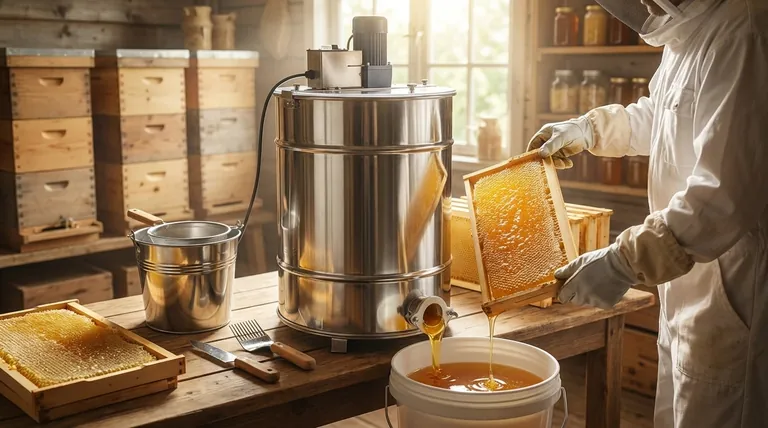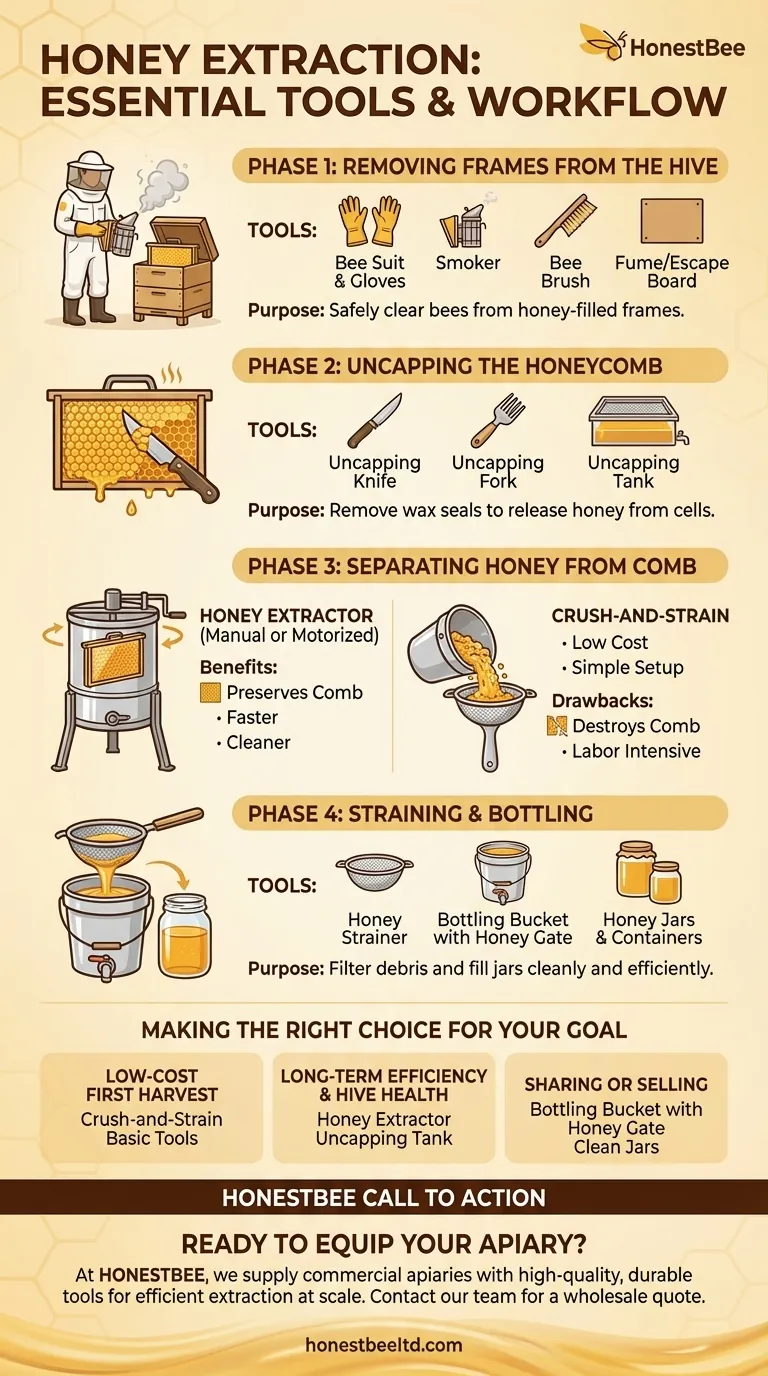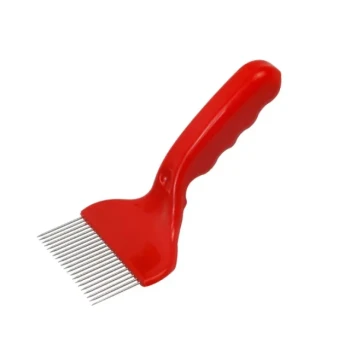Successfully extracting honey requires a specific set of tools designed for three main stages: removing honey-filled frames from the hive, opening the sealed honeycomb, and separating the pure honey from the wax comb. While a basic setup is quite simple, specialized equipment can make the process faster, cleaner, and more efficient, especially as your apiary grows.
While a long list of gear can seem intimidating, the core process is straightforward. Your most significant decision is choosing between using a centrifugal extractor, which preserves the comb for the bees, and the simpler, low-cost crush-and-strain method.

The Three Phases of an Extraction Workflow
The tools you need align with the key stages of the process. Thinking about extraction in this phased approach helps clarify the purpose of each piece of equipment.
Phase 1: Removing Frames from the Hive
Before you can extract honey, you must safely remove the bees from the honey-filled frames, known as "supers."
A beekeeper suit and gloves are non-negotiable for protecting yourself from stings.
A smoker helps calm the bees, making them more docile and easier to work with as you open the hive.
A bee brush is a soft-bristled tool used to gently sweep the remaining bees off the frames without harming them.
For a less hands-on approach, a fume board or triangle escape board can be placed on the hive a day before extraction to clear the bees from the supers with minimal disturbance.
Phase 2: Uncapping the Honeycomb
Bees seal each cell of cured honey with a fresh layer of beeswax. This "capping" must be removed to release the honey.
An uncapping knife is the primary tool for this. You can use a simple, cold serrated knife or a heated electric knife, which melts through the wax for a faster, cleaner cut.
An uncapping fork or scratcher is used to pierce and lift the cappings from areas the knife missed, particularly in recessed parts of the comb.
You will need a container to catch the wax cappings and dripping honey. A simple food-grade bucket works, but a dedicated uncapping tank is better. These tanks often have a sieve to allow honey to drain from the cappings, saving every last drop.
Phase 3: Separating Honey from Comb
This is the core of extraction, where you have two primary methods.
The most common method uses a honey extractor. This is a centrifuge that spins frames at high speed, using centrifugal force to sling the honey out of the cells while leaving the wax comb intact. Extractors can be manual (hand-crank) or motorized.
The alternative is the crush-and-strain method. Here, you simply crush the entire comb into a bucket and then pour the mixture of honey and wax through a strainer. This method does not require an extractor but destroys the comb.
Phase 4: Straining and Bottling
Raw honey from the extractor or crushing process will contain bits of beeswax and other hive debris.
A honey strainer is essential for a clean final product. These are often designed to fit over a 5-gallon bucket and come in progressive layers of coarse and fine mesh. Cheesecloth can also be used.
A bottling bucket is a food-grade pail fitted with a honey gate at the bottom. This simple valve gives you precise control for filling jars without mess or waste.
Finally, you will need clean honey jars or containers with airtight lids to store your harvest.
Understanding the Key Trade-off: Extractor vs. Crush-and-Strain
Your choice of separation method is the most significant decision, impacting cost, efficiency, and the health of your colony.
The Case for a Honey Extractor
The primary benefit of an extractor is that it preserves the drawn comb. Bees expend enormous energy (consuming roughly 8 pounds of honey) to produce just 1 pound of wax.
By returning the empty but intact combs to the hive, you give the colony a massive head start on the next honey flow. This dramatically increases their potential honey production. Extractors are also faster and cleaner for larger harvests.
The Case for the Crush-and-Strain Method
The main advantage of this method is its extremely low cost. You do not need to buy or store a bulky, expensive extractor. For a beekeeper with only one or two hives, this is a perfectly viable and simple way to get started.
The major downside is that you are destroying the bees' hard work. The colony must rebuild every single cell of wax from scratch, consuming valuable time and resources that could have been spent making more honey.
Making the Right Choice for Your Goal
Select your equipment based on your budget, the number of hives you manage, and your long-term beekeeping philosophy.
- If your primary focus is a low-cost first harvest: Use the crush-and-strain method with a food-grade bucket, a basic uncapping knife, and a good strainer.
- If your primary focus is long-term efficiency and hive health: Invest in a honey extractor and an uncapping tank to preserve your comb and maximize future honey production.
- If your primary focus is sharing or selling your honey: A bottling bucket with a honey gate is essential for a clean, professional bottling process.
By understanding the purpose behind each tool, you can confidently assemble the right kit for your specific beekeeping goals.
Summary Table:
| Phase | Key Tools | Purpose |
|---|---|---|
| 1. Removing Frames | Bee Suit, Smoker, Bee Brush | Safely clear bees from honey-filled frames. |
| 2. Uncapping Comb | Uncapping Knife, Uncapping Fork | Remove wax seals to release honey from cells. |
| 3. Separating Honey | Honey Extractor (or Crush-and-Strain) | Spin out honey or crush comb to separate honey from wax. |
| 4. Straining & Bottling | Honey Strainer, Bottling Bucket with Honey Gate | Filter debris and fill jars cleanly and efficiently. |
Ready to equip your apiary for a successful harvest?
At HONESTBEE, we supply commercial apiaries and beekeeping equipment distributors with the high-quality, durable tools needed for efficient honey extraction at scale. Whether you're outfitting a new operation or upgrading your current setup, our wholesale-focused operations ensure you get the right equipment—from manual and motorized extractors to professional uncapping tanks and bottling systems—to maximize your honey yield and protect your colony's health.
Contact our team today to discuss your specific needs and receive a wholesale quote. Let us help you build a more productive and profitable beekeeping business.
Visual Guide

Related Products
- electric honey extractor honey centrifuge 3 frame honey extractor stainless steel honey frame extractor
- Commercial Electric 12 Frame Honey Extractor Spinner Motorized Honey Extractor
- 8-Frame Electric Self-Reversing Honey Extractor Spinner for Commercial Honey Extraction Equipment
- HONESTBEE 72 Frame Industrial Electric Honey Extractor for Beekeeping
- 40 Frame Commercial Electric Honey Extractor for Beekeeping
People Also Ask
- How do automatic honey extractors function? Achieve High-Efficiency Honey Harvesting
- What are the steps for honey extraction using a centrifuge? A Guide to Efficient, Comb-Preserving Harvests
- What are the main processes involved in honey processing? From Hive to Jar, A Complete Guide
- How long does honey take to extract? A Guide to Streamlining Your Harvest Process
- What is the basic principle of the honey extractor? Harness Centrifugal Force for Efficient Harvesting



















